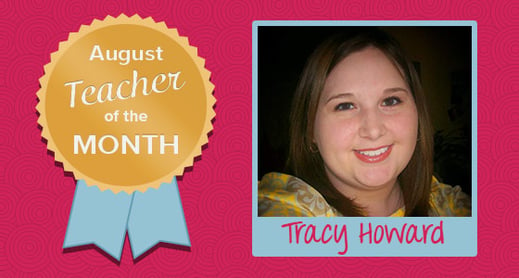
Many of the teachers I have had the pleasure of interviewing have talked about the challenges they face in the classroom like guiding and managing behavior or maintaining enthusiasm for their work. Tracy Howard, our August Teacher of the Month talked about another challenge she ran into—a classroom full of children who didn’t speak English—and how she worked through it.
Tell me a little bit about your program, Tracy.
I work for Community Action of Southern Kentucky in their Head Start program. As an agency, we help families find the resources they need to become successful. One program we provide to the community is Head Start, which allows children from low-income families prepare for Kindergarten. I’ve been working in Warren County in this Head Start program for six years teaching 3 to 5-year-olds. We have seven different preschool classrooms in the building with up to 20 children in each classroom.
That's a lot of children in one classroom. What are some ways you support that many children?
I do a lot of small group work and try to individualize lessons depending on the child’s needs. For example, we were working on a buildings unit and asked the children to create their own house. Some of the children have strong fine motor skills, so I set up their table with scissors. Others tore their paper, and I worked with some children doing hand-over-hand work.
What other challenges do you face in your work?
Our program supports migrant and seasonal workers and refugees, so we have a lot of children who don’t speak English. This past year, almost all of the children in my classroom started the year with little to no English language skills. At the beginning of the year, there were a lot of tears—both the students and mine. Starting school is stressful for children, and when you don’t speak the same language as your teacher, that stress level is much higher. I struggled finding ways to provide comfort and support for these children—let alone teaching them our curriculum.
I had to use gestures and pictures. I also worked with some of our families and asked them to teach me basic words and phrases that I could use to provide some comfort. I invited some of the parents to join me in the classroom to provide some support. Their help made me feel so much more relaxed. Using these tools, I slowly built bonds with all of the children in the classroom and saw them flourish.
We were learning about farms and I realized that the children didn’t know what a cow was. I couldn’t bring a live cow into the classroom, so I built one! I set up a section of the classroom with hay, some farming tools, and this cardboard cow. You could even milk it! I painted t-shirts for the kids to wear so they could pretend to be cows. It was wonderful, and the kids loved it. I learned that I had to be much more creative in my teaching.
I started thinking about how I would feel if I were a child put in a room where people look different, they don’t understand me, and I don’t understand them. Once the children were more comfortable, there was room for them to learn.
I understand your program uses the CLASS tool. How do these language barriers impact your CLASS scores?
Our program uses CLASS to assess program quality and inform professional development. We’ve noticed that our back-and-forth exchanges are especially difficult with the language gaps in our classrooms. As the year goes on, our kids become more comfortable and begin to pick up more and more English, so the exchanges improve. It's amazing to see the results of our work in our CLASS scores. Because we support ages 3-5, it’s great to have the children back from year to year so we can build on the learning from the past year.
What do you think makes you an excellent teacher?
Creativity. I use my creativity to build and make things to use in my classroom to help express what we are learning about.
What advice would you like to share with other teachers?
I think I’m a much better teacher after this year. I was incredibly stressed and frazzled at the beginning of the year. The fact that my children didn’t speak English was tough. I couldn’t comfort them. I knew I needed to make everything work, and I had to work really, really hard. I shifted my focus and priorities from what I had done in previous years to the interactions in the classroom and building relationships. I had to get creative.
I saw so much growth in the kids—whether they spoke English or not. The new activities and relationship-building that we worked on opened up the classroom and brought us all together. I feel like I’m reinvigorated as a teacher and can’t wait for next year.
When things get tough, you can’t give up. You have to be open-minded and maybe change the way you do things. Change is a lot easier if you take a step back and look at the bigger picture. The year was so scary but it made me a better person and teacher.

